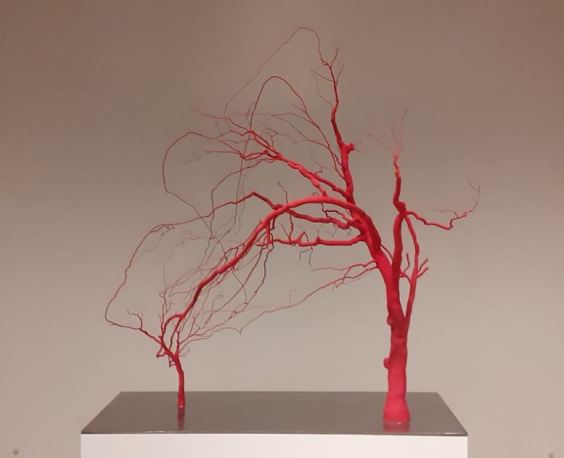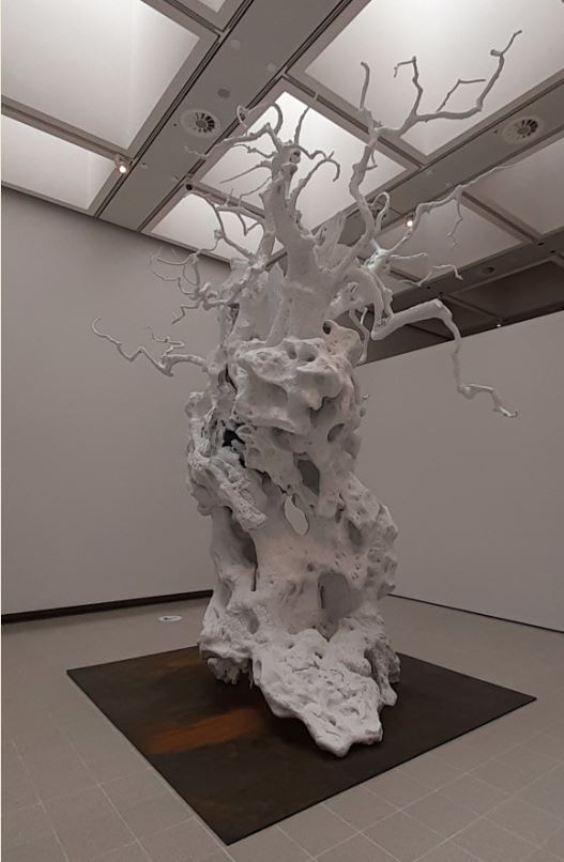
There is a checklist I have of steps to normality. Catch a train – done. Sit at a table in a coffee shop and drink coffee while reading newspaper – done. Visit a second-hand bookshop – done. See any sort of cricket played live – done. There are many steps yet to be achieved, alas – go to a cinema, go to a theatre, buy groceries without having to wear a mask that makes me look like I wanted to rob the place, hug a friend. But one vital step was ticked off this weekend – visit an art gallery.
So I went to the Hayward Gallery in London, one of the growing number of galleries now able to invite visitors, subject to booking ahead, visitor control measures, social distancing and timed entry. The exhibition I went to was ‘Among the Trees.’ It was excellent, and yet it puzzled me.
I arrived at 11:30, donned my mask, showed the e-ticket on my phone to the similarly masked man at the door, and he waved me through. The cheery woman at the desk, secure behind perspex, swiped my phone with a reader which bleeped and flashed to indicate that it was satisfied. I was told that I could photograph of some of the artworks, but not all of them, and that I had to follow the arrows on the floor, so that I would process through the exhibition via the prescribed route only. I said yes to all this, smiled pointlessly (masks hide so much), pushed at the double doors, and I was in.

‘Among the Trees’ is an exhibition about trees. It features art works inspired by trees, featuring trees, and occasionally made from trees. It has paintings, photographs, video installations, sculptures, 3D constructions and some objects that defy classification. It features some renowned artists – Tacita Dean, Peter Doig, Steve McQueen – alongside many names previously unknown to me, but clearly known to a clever curatorial team, who must have visited many galleries or flicked through many catalogues to compile so varied, so entrancing and so global a show.

Its subject is trees, and what distinguishes the exhibition in particular is how the trees are isolated – taken out of their natural contexts, in effect. There is no traditional landscape view here. The trees stand alone. Even when photographs are displayed (and there are many startling high-resolution photographs) that show trees in situ, there is always a studied unreality about them, so that everything focusses on the subject. This is exemplified by, and mocked by, Myoung Ho Lee’s ‘Tree… #2’, in which a tree on a plain has been photographed with a large white canvas behind it. You literally cannot see the wood for the trees.

There are some exquisite drawings and paintings of a moderate size, but inevitably the larger works create the greatest impact. Two vast video installations each take up the entire wall of a room. Eija-Liisa Ahtila’s video artwork ‘Horizontal – Vaakasuora’ displays a tall pine tree horizontally across six adjacent screens, each video slightly out of sync with the others. It is ingenious, if slightly ridiculous. Well, hugely ridiculous really, since there is nothing slight about it. I preferred ‘Blind Eye, 1’ by Jennifer Steinkamp, an astonishing widescreen view of a line of trees changing through the seasons in hyper-realistic animation. You watch open-mouthed, incredulous at what your eyes permit you to see.

Among the more modest works, I was particularly drawn to Gillian Carnegie’s engrossing painting of a spiky tree in green, ‘Section’ (2015); to Mariele Neudecker’s otherworldly water-tank with submerged imaginary forest, ‘And Then the World Changed Colour: Breathing Yellow’ (shown in part at the top of the post); and to the quiet photograph by Steve McQueen, director of 12 Years a Slave, of a Louisiana lynching tree. Its positioning is, in every sense, perfect.

‘Among the Trees’ is an exhibition with a message; several messages. This you expect – exhibitions have to be about something. Its website avers that these artworks “challenge how we think about time, and consider how intimately entangled they are with human affairs.” Label after label, in rather too wordy a fashion, tells us of the significance of these objects, of these trees without a landscape. They tell us of the environment, of climate change, of our profound relationship with the natural, of the inexorability of time, of the fragility of things. These are the beliefs of the artists, not just of the curators. They are works that say something, because the artist cannot stay silent.

Maybe there is something cold inside of me, but I felt none of this. I felt for some of the matters raised, but for themselves as issues, not as expressed through the artworks. What I saw was many ways in which to observe a tree. I saw ingenuity, great skill, some beauty, but something was missing. Every tree had been uprooted, displanted in the act of being displayed. In some way, they had stopped being trees. A good exhibition – and this is a very good exhibition – can make you see the world anew, the moment you step out of the gallery. New shapes, lines, colours and connections become apparent. You see things anew, as though with an artist’s eye.

This didn’t happen to me. I passed through the double doors once more, by-passed the queue for the gift shop, went through the exit door and removed the mask. The world was as it was before – trying to appear normal, yet not quite achieving it. Perhaps art can only thrive with normality. It has to off-set the familiar, to make us look again. But currently we live in some sort of global-wide art installation, where everything disorients. We look with confusion at where we find ourselves. There must be a lesson, but we have not learnt it yet. In such a time, what purpose can art have, except for the nostalgic act of experiencing it as once we did?
I do not know. I must go to another exhibition to find out. And then another. And another.
Links:
- ‘Among the Trees‘ continues at the Hayward Gallery London until 31 October 2020
- I like to photograph trees